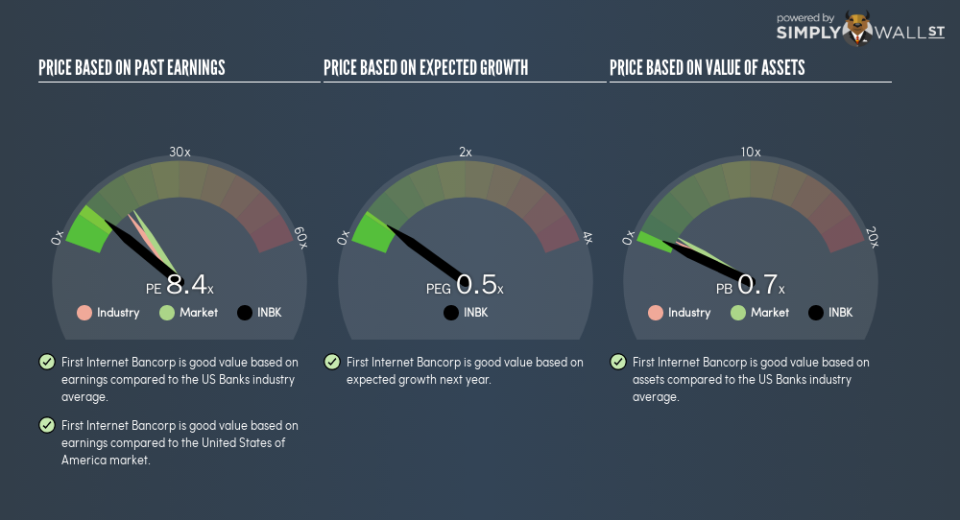Do You Know What First Internet Bancorp’s (NASDAQ:INBK) P/E Ratio Means?

The goal of this article is to teach you how to use price to earnings ratios (P/E ratios). We’ll show how you can use First Internet Bancorp’s (NASDAQ:INBK) P/E ratio to inform your assessment of the investment opportunity. First Internet Bancorp has a P/E ratio of 8.42, based on the last twelve months. In other words, at today’s prices, investors are paying $8.42 for every $1 in prior year profit.
Check out our latest analysis for First Internet Bancorp
How Do I Calculate A Price To Earnings Ratio?
The formula for price to earnings is:
Price to Earnings Ratio = Price per Share ÷ Earnings per Share (EPS)
Or for First Internet Bancorp:
P/E of 8.42 = $20.31 ÷ $2.41 (Based on the trailing twelve months to September 2018.)
Is A High Price-to-Earnings Ratio Good?
A higher P/E ratio implies that investors pay a higher price for the earning power of the business. All else being equal, it’s better to pay a low price — but as Warren Buffett said, ‘It’s far better to buy a wonderful company at a fair price than a fair company at a wonderful price.’
How Growth Rates Impact P/E Ratios
Probably the most important factor in determining what P/E a company trades on is the earnings growth. Earnings growth means that in the future the ‘E’ will be higher. Therefore, even if you pay a high multiple of earnings now, that multiple will become lower in the future. A lower P/E should indicate the stock is cheap relative to others — and that may attract buyers.
First Internet Bancorp’s earnings per share were pretty steady over the last year. But it has grown its earnings per share by 16% per year over the last five years.
How Does First Internet Bancorp’s P/E Ratio Compare To Its Peers?
The P/E ratio indicates whether the market has higher or lower expectations of a company. We can see in the image below that the average P/E (14.1) for companies in the banks industry is higher than First Internet Bancorp’s P/E.
This suggests that market participants think First Internet Bancorp will underperform other companies in its industry. Since the market seems unimpressed with First Internet Bancorp, it’s quite possible it could surprise on the upside. If you consider the stock interesting, further research is recommended. For example, I often monitor director buying and selling.
Remember: P/E Ratios Don’t Consider The Balance Sheet
Don’t forget that the P/E ratio considers market capitalization. Thus, the metric does not reflect cash or debt held by the company. In theory, a company can lower its future P/E ratio by using cash or debt to invest in growth.
Such expenditure might be good or bad, in the long term, but the point here is that the balance sheet is not reflected by this ratio.
First Internet Bancorp’s Balance Sheet
First Internet Bancorp’s net debt is considerable, at 176% of its market cap. If you want to compare its P/E ratio to other companies, you must keep in mind that these debt levels would usually warrant a relatively low P/E.
The Bottom Line On First Internet Bancorp’s P/E Ratio
First Internet Bancorp’s P/E is 8.4 which is below average (16) in the US market. It’s good to see EPS growth in the last 12 months, but the debt on the balance sheet might be muting expectations.
Investors have an opportunity when market expectations about a stock are wrong. As value investor Benjamin Graham famously said, ‘In the short run, the market is a voting machine but in the long run, it is a weighing machine.’ So this free visual report on analyst forecasts could hold they key to an excellent investment decision.
Of course you might be able to find a better stock than First Internet Bancorp. So you may wish to see this free collection of other companies that have grown earnings strongly.
To help readers see past the short term volatility of the financial market, we aim to bring you a long-term focused research analysis purely driven by fundamental data. Note that our analysis does not factor in the latest price-sensitive company announcements.
The author is an independent contributor and at the time of publication had no position in the stocks mentioned. For errors that warrant correction please contact the editor at editorial-team@simplywallst.com.

